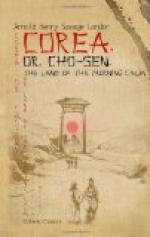The royal palace may be considered as divided into two portions, namely, the summer palace and the winter palace. An official, who came to meet me in the inner enclosure, informed me that His Majesty desired that I should begin by inspecting the summer palace—access to which is not allowed during the winter time—and that he had given orders for the gates leading to it, which had been nailed up and sealed, to await the next warm weather, to be opened for me. No one besides myself and the official to guide me was, however, to be allowed to enter. And so, preceded by a man with a heavy wooden mallet, we arrived at the gate, which, after a considerable amount of hammering and pegging away, was at last forced open. Accompanied by my guide, I straightway entered, two soldiers being left on guard to prevent any one else following. As I got within the enclosure, a pretty sight lay before me. In front was a large pond, now all frozen, in the centre of which stood a large square sort of platform of white marble. On this platform was erected the audience-hall, a colonnade of the same kind of white marble, supported by which was another floor of red lacquered wood with wooden columns, which in their turn upheld the tiled roof with slightly curled up corners. The part directly under the roof was beautifully ornamented with fantastic wood carvings painted yellow, red, green and blue. Red and white were the colours which predominated. A black tablet, with large gold characters on it, was at one side.
The throne in the audience-hall was a simple raised scaffold in the centre of the room, with a screen behind it, and a staircase of seven or eight steps leading up to it. Access to this sort of platform-island from the gate at which we entered was obtained by means of a marble bridge, spanned across on two strong marble supports. The staircase leading to the first floor was at the end of the building, directly opposite to where the bridge was; so that, on coming from the bridge, we had to go through the whole colonnade to reach it.




